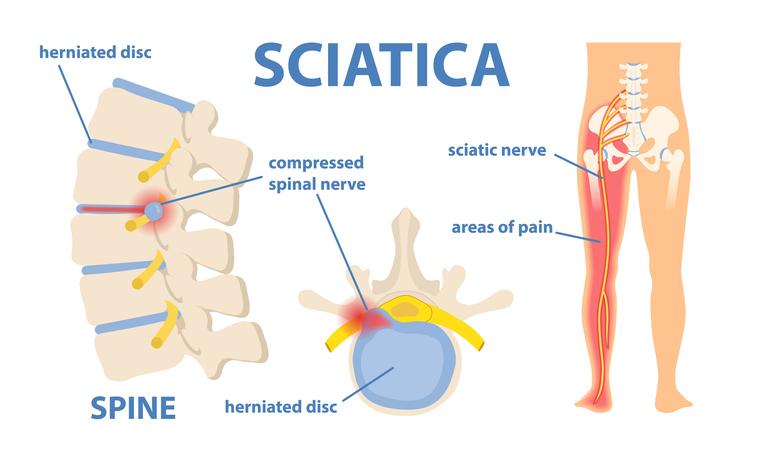Pain
Sciatica Chronic Pain Treatments

What is sciatica?
Sciatica, or sciatic nerve pain, refers to pain that occurs when the sciatic nerve root in the lower back becomes compressed, irritated or inflamed. Sciatic nerve pain radiates from the lower back, into the buttocks, and down the legs. It is most commonly the result of a herniated or slipped disc, bone spurs, or spinal stenosis.
The type of sciatica is dependent upon one or both legs being affected and the duration of symptoms. Sciatica types include acute, chronic, alternating and bilateral.
Sciatica treatment
Diagnosing the underlying cause of sciatica is essential in managing pain and implementing an appropriate treatment plan. A health care provider may suggest a combination of medications, therapies, alternative care, surgery, and at-home treatments for sciatica.
Medications
Medication may include over-the-counter (OTC) anti-inflammatory, such as acetaminophen, aspirin or naproxen. Muscle relaxers can reduce muscle spasms, while oral steroids can reduce inflammation. Tricyclic antidepressants and anticonvulsant medications offer pain relief. If pain is severe, an opioid may be prescribed.
Physical therapy
A physical therapist can provide stretches and exercises to decrease sciatica pain and reduce pressure on the sciatic nerve. Exercises should be done exactly as directed and are dependent upon the cause of sciatica.
Massage therapy
Massage therapy involves a trained professional that manipulates the soft tissue, including muscles, tendons, and ligaments, with varying degrees of pressure and movement to increase mobility and relieve pain. Blood circulation is also improved, which promotes the body’s healing process.
Alternative care
Alternative and complementary treatments may also help ease pain associated with sciatica. Examples include the following:
- Biofeedback is a technique in which an individual can learn to control specific bodily functions, such as heart rate, breathing, muscle contractions, and brainwaves, to relax muscles or reduce pain.
- Acupuncture is performed by a licensed professional and involves inserting fine, thin needles into the skin at specific points of the body. The strategic placement of the needles stimulates muscles, nerves and connective tissues.
- Chiropractic treatment is conducted by a licensed chiropractor to improve the alignment of the spine, decrease pain, and improve functionality. If the underlying cause of sciatica is a herniated disc or spinal stenosis, chiropractic treatment may be beneficial.
Surgery
Spinal surgery is a last option for sciatica. It can remove pressure from the affected sciatic nerve. Surgical options include a microdiscectomy, which is minimally invasive and removes offending fragments of a herniated disc or bone spur, or a laminectomy, which removes part of the vertebral bone causing pressure on the sciatic nerve.
At-home treatment
Sciatica pain may be relieved with certain at-home treatment options. Most cases resolve on their own within a few weeks; however, if pain is severe and debilitating, a health care professional should be consulted. Examples of at-home treatment include the following:
- Temperature therapy involves the use of heat or cold to reduce pain. Heat therapy relaxes stiff joints and muscles; whereas, cold therapy numbs acute pain and reduces inflammation.
- Physical activity includes gentle stretching exercises for the lower back to help reduce pressure on the sciatic nerve root while keeping the muscles flexible. Stretches should be held for approximately 30 seconds.
- Rest can provide time to heal, reduce inflammation, and help reduce pain. However, prolonged inactivity can cause the joints to stiffen and the muscles to become weak.

















